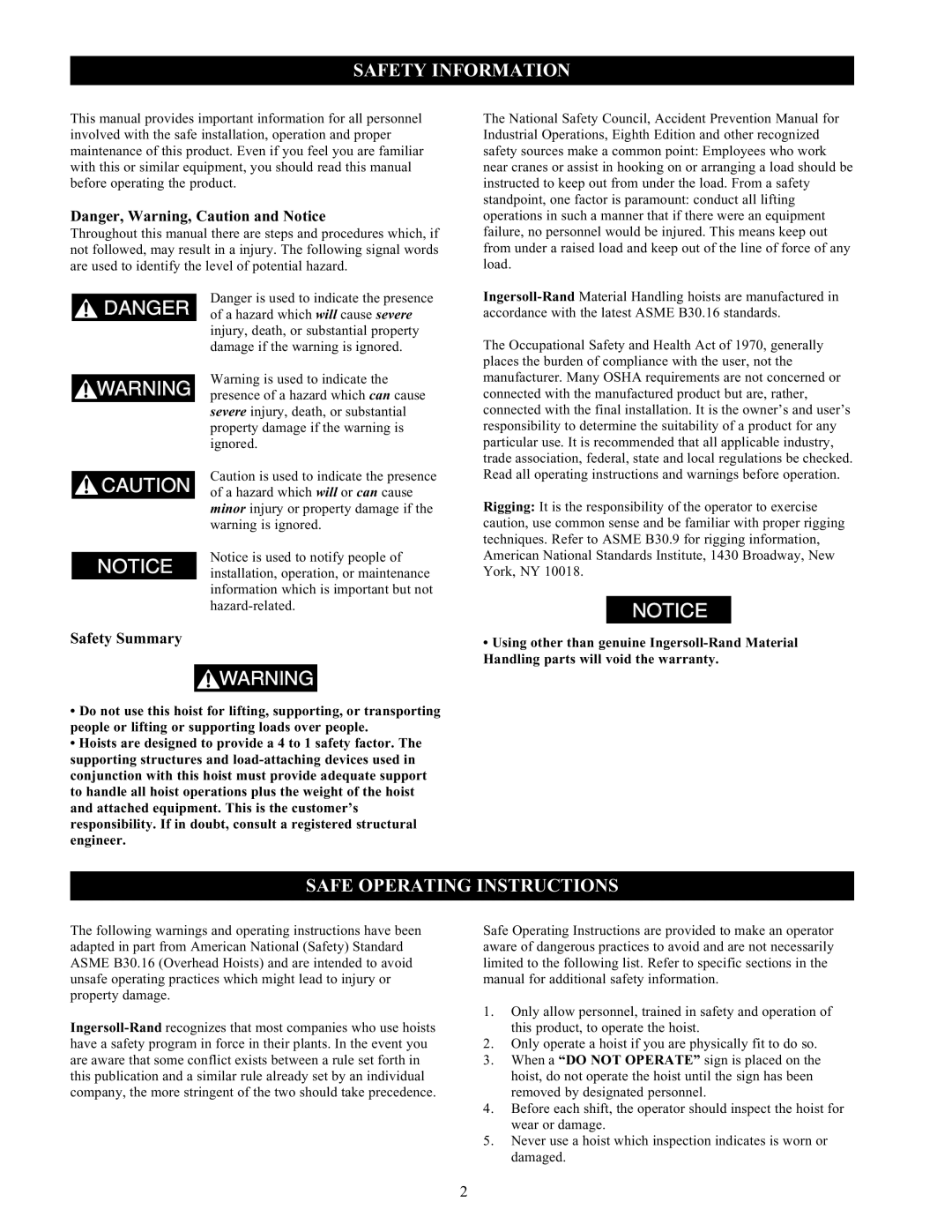
SAFETY INFORMATION
This manual provides important information for all personnel involved with the safe installation, operation and proper maintenance of this product. Even if you feel you are familiar with this or similar equipment, you should read this manual before operating the product.
Danger, Warning, Caution and Notice
Throughout this manual there are steps and procedures which, if not followed, may result in a injury. The following signal words are used to identify the level of potential hazard.
DANGER | Danger is used to indicate the presence | |
of a hazard which will cause severe | ||
| injury, death, or substantial property | |
| damage if the warning is ignored. | |
| Warning is used to indicate the | |
WARNING | ||
presence of a hazard which can cause | ||
| severe injury, death, or substantial | |
| property damage if the warning is | |
| ignored. | |
| Caution is used to indicate the presence | |
CAUTION | ||
of a hazard which will or can cause | ||
| minor injury or property damage if the | |
| warning is ignored. | |
| Notice is used to notify people of | |
NOTICE | ||
installation, operation, or maintenance | ||
| information which is important but not | |
|
Safety Summary
![]()
![]() WARNING
WARNING
•Do not use this hoist for lifting, supporting, or transporting people or lifting or supporting loads over people.
•Hoists are designed to provide a 4 to 1 safety factor. The supporting structures and
The National Safety Council, Accident Prevention Manual for Industrial Operations, Eighth Edition and other recognized safety sources make a common point: Employees who work near cranes or assist in hooking on or arranging a load should be instructed to keep out from under the load. From a safety standpoint, one factor is paramount: conduct all lifting operations in such a manner that if there were an equipment failure, no personnel would be injured. This means keep out from under a raised load and keep out of the line of force of any load.
The Occupational Safety and Health Act of 1970, generally places the burden of compliance with the user, not the manufacturer. Many OSHA requirements are not concerned or connected with the manufactured product but are, rather, connected with the final installation. It is the owner’s and user’s responsibility to determine the suitability of a product for any particular use. It is recommended that all applicable industry, trade association, federal, state and local regulations be checked. Read all operating instructions and warnings before operation.
Rigging: It is the responsibility of the operator to exercise caution, use common sense and be familiar with proper rigging techniques. Refer to ASME B30.9 for rigging information, American National Standards Institute, 1430 Broadway, New York, NY 10018.
NOTICE![]()
![]()
•Using other than genuine
SAFE OPERATING INSTRUCTIONS
The following warnings and operating instructions have been adapted in part from American National (Safety) Standard ASME B30.16 (Overhead Hoists) and are intended to avoid unsafe operating practices which might lead to injury or property damage.
Safe Operating Instructions are provided to make an operator aware of dangerous practices to avoid and are not necessarily limited to the following list. Refer to specific sections in the manual for additional safety information.
1.Only allow personnel, trained in safety and operation of this product, to operate the hoist.
2.Only operate a hoist if you are physically fit to do so.
3.When a “DO NOT OPERATE” sign is placed on the hoist, do not operate the hoist until the sign has been removed by designated personnel.
4.Before each shift, the operator should inspect the hoist for wear or damage.
5.Never use a hoist which inspection indicates is worn or damaged.
2
